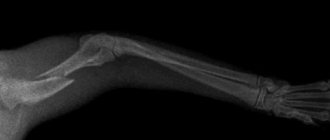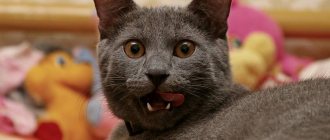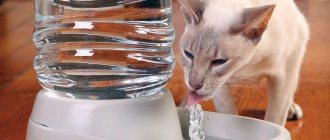Why does a cat limp on its hind leg without visible damage?
Most often, cat lameness is caused by a physical injury, but some diseases and disorders can also cause pain, causing the cat to stop walking.
Visible and invisible reasons:
- fracture (closed or open);
- dislocation;
- sprained ligaments;
- improperly formed joints;
- arthrosis of the joints;
- arthritis;
- injury;
- lower back injuries;
- long claws;
- osteosarcoma (oncology), etc.
Why might a cat shake its paw or pull it back?
Sometimes cat/cat breeders notice that the pet is shaking its paw or pulling it back.
This can happen for several reasons:
- Ticks. The parasites attach themselves to the soft pad on the paw and burrow into the flesh. This causes severe discomfort to the animal, so the cat shakes the limb to relieve the pain. The pet owner can detect the tick by visually inspecting the paw and remove it.
- Worms . The appearance of helminthic parasites in an animal’s body can be noticed by the following symptoms: the cat is constantly restless, shakes one or the other paw, and sometimes eats poorly. Worm eggs can also enter the human body when he caresses or kisses a pet, so medical consultation is extremely important here.
- Inconvenience after sterilization. After sterilization, a special blanket is put on the animal to prevent licking the healing scar. It usually bothers cats, and they try to remove it in every possible way. At the same time, they can shake their hind legs.
- Scotch tape, glue, chewing gum, splinter. Cats, especially those who walk outside, often catch pieces of adhesive tape, chewing gum, resin, splinters, etc. on their paws. Sensing a foreign object on the pad, the pet shakes the limb in an attempt to get rid of it.
Be sure to read:
The cat has a swollen paw and is limping: what to do, main reasons, first aid, treatment methods
Physiotherapy for cats with leg paralysis
The recovery period after paralysis drags on for a long time; in this case, the animal owner cannot do without physiotherapy.
Veterinarians advise performing a daily set of exercises to help restore neurological functions.
- Passive movements. Place the cat on its back and move the paralyzed legs alternately in a circular motion for at least five minutes. The exercise is similar to riding a bicycle.
- Stimulating massage. Stretch your paw pads and limbs daily.
- Scratching. Scratch the paralyzed animal in different places; even with little progress, the cat will try to scratch with its hind paw.
- Using an inflatable ball. Place the cat on its stomach on the ball, so that its paws lightly touch the floor. Roll the ball while holding your pet back and forth.
- Using support. Pass a wide strip of fabric under your pet's belly and try to walk with the animal, holding the ends of the fabric.
- Moving limbs. Take the cat by the hind legs and slowly move them, imitating walking.
- Swimming. Make the cat swim in the bath every day, holding the animal so that it does not choke.
Be sure to read:
The cat has a fever: what to do, reasons, what is the norm, how to bring it down at home, the best methods
What to do if your cat is limping with fractures and bruises
A cat's paw bruise is not uncommon, especially in young cats. During play, kittens actively run and jump, which can result in injury. The bruise does not threaten the life of the animal, but requires treatment to avoid inflammation.
Fractures in cats are a serious injury that threatens the health and life of the pet.
You cannot do without medical help here.
Fractures and bruises: how to recognize and what to do
The first sign of damage is that the animal holds the affected paw up and does not step on it. If it occurs occasionally, he tries to transfer the body weight to a healthy limb as soon as possible. A bruise can be identified by the following symptoms:
- hematoma in the injured area;
- swollen paw;
- impaired gait with lameness;
- absence of skin wounds;
- absence of displaced joints;
- local temperature increase;
- constant licking of the sore spot (the animal massages the paw with its tongue, accelerating the resorption of the hematoma);
- aggressive behavior when the owner tries to touch the damaged limb.
Fractures have their own distinctive features:
- swollen paw along the entire length, and not just at the site of injury;
- when palpating (feeling) the paw, a displacement of the joints or bones is felt;
- the animal does not attempt to step on the limb;
- due to severe pain, the pet constantly meows;
- the structure of the paw is damaged.
If an animal is bruised, you must first calm it down by picking it up and gently stroking it for several minutes. Then apply cold to the bruised area - a cloth in which ice is wrapped or a towel soaked in cold water. You need to apply it for 1 minute, then take a break for half a minute, and then repeat the procedure again. This must be done for 15 minutes.
A couple of hours after injury, you can do an alcohol rub. You should not put too much pressure on the sore spot - this will cause anxiety and stress in the cat. An alcohol compress can be applied to a calm animal, which effectively relieves swelling and pain.
Be sure to read:
How dangerous are ulcers in a cat’s mouth, and how should they be treated?
And when should you worry about a cat’s life? In case of a fracture, it is necessary to provide maximum rest to the animal, place it in a carrier or take it to a bed. The diseased limb must be fixed to avoid displacement of bones and joints, and then urgently taken to a veterinary clinic.
Important! Never set a broken bone yourself!
If your pet is suspected of having a spinal fracture, you should move it as carefully as possible onto a rug or blanket, take it to the car and take it to the veterinarian as soon as possible. Any displacement of the vertebrae can result in damage to the spinal cord. If the jaw is broken, it is necessary to put a muzzle on the cat - this will protect it from shifting bone fragments that threaten to rupture the soft tissues.
Patella luxation
Patella, or dislocation of the stifle, is uncommon in cats. The main reasons for its appearance are severe injuries or genetic abnormalities. The disease occurs suddenly: the animal experiences severe pain, cannot move normally, limps, and reacts to stroking with hissing and aggressive behavior. The pet constantly meows, he is scared. In such a situation, they act immediately - the animal is urgently hospitalized.
General symptoms
In addition to individual signs of the disease, characteristic only of one of its forms, there are several general symptoms by which ataxia can be identified:
- The cat has a wobbling gait with drifts to the side.
- When walking, the paws are widely spaced; The animal seems to be constantly afraid of falling.
- Often falls while walking or running.
- Rarely holds head straight; more often - with an inclination to the side or down.
- Does not control her body: even with fairly confident walking, she is not able to jump, go down/ascend, or turn around a turn.
- In severe cases, he cannot consistently perform the simplest movements. Remains in one place, but wobbles a lot and falls.
- Partially or completely not oriented in space. Bumps into objects and does not know how to calculate real distance.
We invite you to read: American Shorthair cat all about the breed
Diseases of the joints and bones
Joint and bone diseases appear in cats, as a rule, at 7-8 years of age - these are the first signs of aging. However, young individuals often develop ailments, many of which are transmitted genetically. Common diseases of the joints and bones of felines include arthrosis and arthritis, osteochondrosis, traumatic arthrosis, osteomyelitis, etc.
Arthrosis
Arthrosis is a non-inflammatory chronic disease. It is asymptomatic for a long time - degenerative reformations in soft tissues, bones and cartilage develop gradually. One of the common causes is a congenital defect of the anatomical structure of the animal. Mostly adults are affected, but sometimes the disease also affects young pets.
Be sure to read:
Pulmonary edema in cats: what is it, causes, symptoms, first aid, treatment, is it dangerous?
Traumatic arthrosis
Traumatic arthrosis is caused by injuries received in youth. Bruises and dislocations that go unnoticed by the owner with age lead to incorrect alignment of bones, cartilage and soft tissues. Often the cause is damage to the lumbar region. This usually happens when landing incorrectly from a height, being hit on the back with a stick, or fighting with dogs. Pinched nerve endings at such a moment lead to severe lameness and discomfort.
Vestibular ataxia
The diagnosis is made in two cases: with an affected structure of the inner ear and with tumors of the brain stem or medulla oblongata.
Adult animals over 10 years of age are most susceptible to the disease. The cat has difficulty standing, can walk in circles, or fall over on one side.
The head is either thrown back or tilted towards the affected side. Movements are slow and careful. Concomitant strabismus and nystagmus are often found, and in some cases there is also periodic vomiting.
We suggest you read: How to treat goslings that fall on their feet || Why goslings don’t get to their feet diagnostics
The appearance of vestibular ataxia is provoked by:
- otitis;
- brain tumors;
- bacterial infections and abscesses of the ear canal;
- excessively intense and traumatic ear cleaning;
- medication overdose;
- use of aminoglycoside antibiotics;
- liver or kidney dysfunction (in rare cases).
First aid for a cat
If you notice lameness in your pet, immediately identify the cause of the problem. If the wound is open, you need to disinfect it by removing the hair around the injury and rinsing the lesion with a solution of furatsilin. After this, apply a sterile bandage and take it to the veterinarian.
In case of a fracture, dislocation, or sprain, immobilize the animal as much as possible, ensuring complete rest, injecting an anesthetic and urgently calling a doctor.
Avoid self-medication! At the clinic, the doctor will take an x-ray and make a diagnosis. If necessary, a fixative bandage is applied; in difficult situations, a splint or plaster cast is used. The animal is given anti-inflammatory drugs and antibiotics.
Arthritis treatment
Therapy for arthritis involves the use of antibiotics, as well as dietary supplements, such as chondroitin or glucosamine. The pet is also advised to take painkillers and fish oil. For arthritis, the doctor prescribes a light massage, the most comfortable conditions for the sick animal, and a diet.
Medications include anti-inflammatory (if necessary) and decongestant drugs. Therapy using a Minin lamp is useful for cats. Severe, neglected situations often have a disastrous outcome: the pet suffers from severe pain, and the injured limb is sometimes paralyzed.











